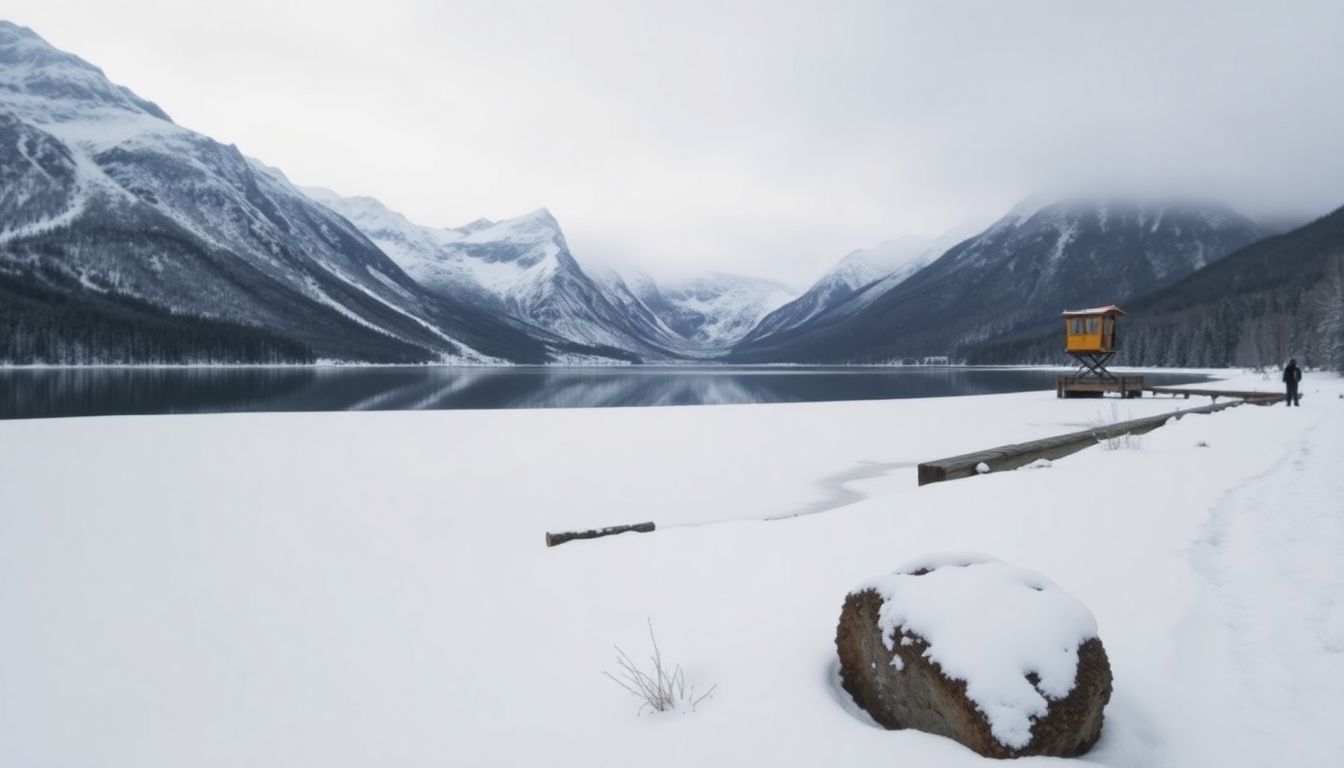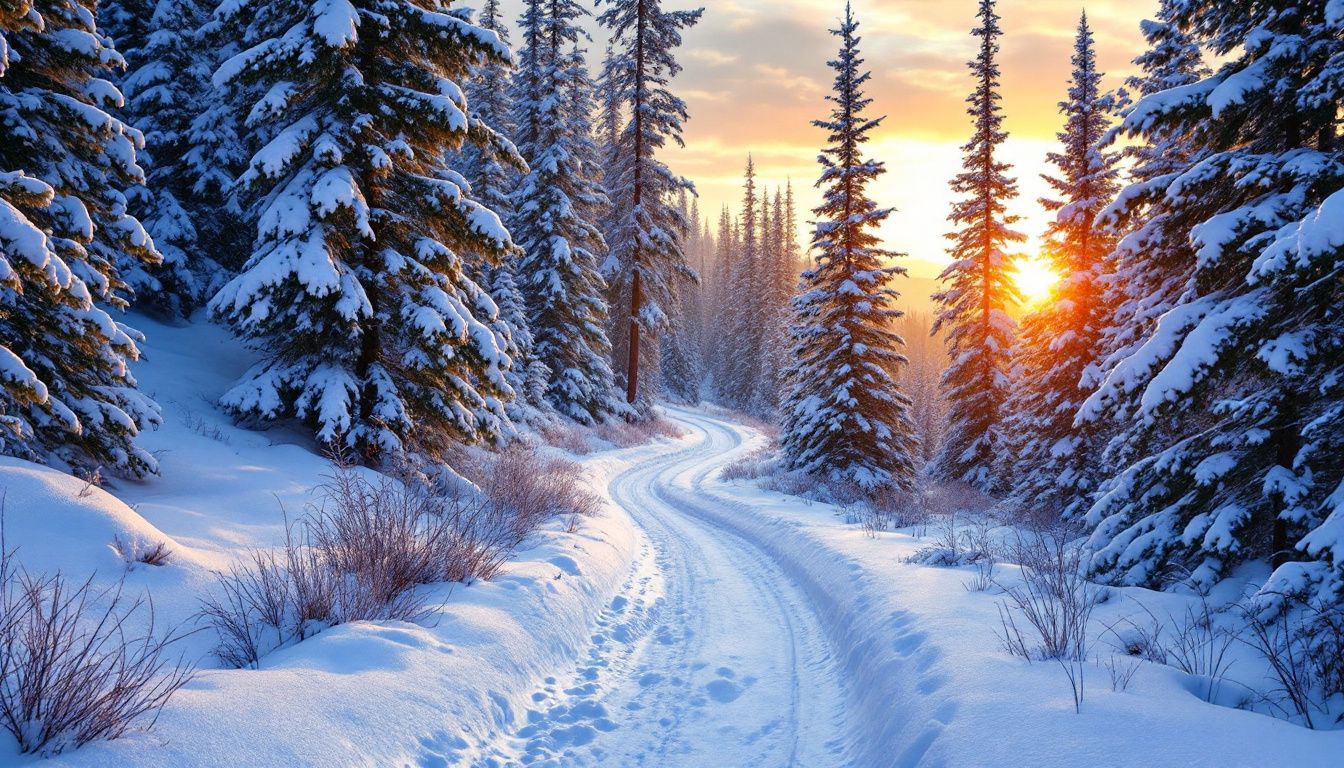Winter hiking sounds exciting, but it can also feel overwhelming. Trails like the Enchantments or Colchuck Lake transform into snowy wonderlands this season. This blog explores the beauty and challenges of winter trails, offering tips to prepare for your adventure.
Thank you for reading this post, don't forget to subscribe!Stay tuned—it’s worth reading!
Key Takeaways
- Winter hiking offers stunning views, like snow-covered lakes and peaks such as Colchuck Lake and Aasgard Pass. Quiet trails provide peace away from crowds.
- Challenges include harsh weather, icy paths, and risks like frostbite or hypothermia. Proper gear is critical for safety.
- Preparation matters: check forecasts, pack layers, bring safety tools (maps/compass), and wear insulated boots with good traction.
- Know your limits before tackling steep climbs or snowy terrain on trails such as Snow Lakes Trail or Stuart Lake Trailhead. Fitness level impacts safety.
- Decide if winter hiking suits you based on cold tolerance, physical ability, and experience with alpine conditions.
The Enchantment of Winter Trails
Winter trails offer quiet moments and stunning sights. Snow-covered alpine lakes and towering peaks like Aasgard Pass create a magical escape.
Scenic beauty
Snow turns the trails into magical paths. Enchantment Lakes reflect icy blue skies, creating postcard-perfect views. Icicle Creek sparkles under winter sunshine as frost clings to branches like crystals.
Alpine meadows look like powdered sugar spread across granite terrain.
Hikers marvel at snow-covered peaks near Prusik Peak and Little Annapurna. Colchuck Lake freezes into a mirror of white and silver surrounded by jagged cliffs. Even the simplest trail, like Stuart Lake Trailhead, feels special covered in untouched snowdrifts.
To appreciate the beauty of a snowflake it is necessary to stand out in the cold. – Aristotle
Tranquility
Winter trails offer a calm escape from busy hiking paths. Alpine lakes like Colchuck Lake and Perfection Lake sit undisturbed, surrounded by snow-covered granite terrain. Near the Core Enchantments Zone, the quiet of winter creates a unique stillness that feels untouched.
Icicle Creek Road and trailheads like Stuart Lake Trailhead see fewer visitors this time of year.
Hikers often enjoy moments alone with nature in spots like Isolation Lake or Leprechaun Lake. The muffled sound of footsteps on snow adds to the peaceful atmosphere. Day hikes here feel more personal and serene without crowded paths or noisy groups.
Unique winter landscapes
Snow blankets the alpine terrain, creating stunning views all around. Trails like Snow Lakes and Stuart Lake Trailhead shimmer under frost, offering a magical experience. Icicle Creek Road turns into a sparkling pathway leading hikers to breathtaking sights.
Wildlife adds charm to these snowy scenes. Mountain goats roam near Colchuck Lake or by Inspiration and Perfection Lakes. The frozen lakes—Leprechaun, Isolation, and Crystal—turn into icy mirrors reflecting rugged peaks like Dragontail Peak or Little Annapurna.
The Hardships of Winter Hiking
Winter hiking can push your body and mind to their limits. The icy trails, steep elevation gain, and unpredictable weather aren’t for the faint of heart.
Harsh weather conditions
Snowfall and icy winds make trails like Aasgard Pass tough in winter. Temperatures often drop below freezing, increasing the risk of frostbite and hypothermia. Layers of snow can hide trail markers, making navigation harder around places like the Core Enchantments Zone.
Strong gusts blow through alpine meadows near Isolation Lake or Perfection Lake. These conditions demand extra caution while climbing granite terrain or steep elevation gains near Stuart Lake Trailhead.
Cold air also drains body heat quickly, even during day hikes on Colchuck Lake Trail.
Physical challenges
Snow-covered trails can make hiking harder. Deep snow slows down steps, and slippery paths test balance. The steep elevation gain on routes like Aasgard Pass pushes muscles to the max.
Trails such as the Snow Lakes Trail or Stuart Lake Trail demand endurance, especially with backpacks full of winter gear.
Cold air makes breathing tougher during climbs. Uneven granite terrain around Colchuck Lake challenges ankles and knees. Carrying extra weight from safety equipment adds strain, even for seasoned hikers.
Trekking near areas like Inspiration Lake or Little Annapurna further tests physical limits due to icy surfaces and strong winds barreling through alpine meadows.
Risks of frostbite and hypothermia
Cold temperatures can quickly lead to frostbite and hypothermia. Frostbite happens when the skin and tissues freeze, often affecting fingers, toes, ears, or nose. Skin may turn pale or gray and feel numb.
These risks increase without proper gear like gloves or insulated boots on trails like Snow Lakes Trailhead or Aasgard Pass.
Hypothermia sets in when the body loses heat faster than it produces it. Symptoms include shivering, confusion, slurred speech, and fatigue. Hiking areas such as Colchuck Lake Trail with icy winds and high elevation gain make this more likely.
Preparing well—like layering clothing—can help avoid these dangers. Proper preparation is key before tackling physical challenges in winter hiking conditions.

Preparation for Winter Hiking
Preparation is key for winter hiking—being ready can make your trip safe and enjoyable.
Checking weather forecasts
Check forecasts daily before heading out. Winter weather can change fast in alpine lakes wilderness. Heavy snow or sudden winds near places like Colchuck Lake Trail make hiking dangerous.
Knowing conditions helps avoid risks like hypothermia.
Use reliable sources like recreation.gov or local trail stations for updates. Trails such as Snow Lakes Trailhead may have warnings about icy paths or elevation gains affected by storms.
A clear day forecast makes exploring areas like the Enchantment Lakes safer and more enjoyable!
Packing essential gear
Carry layers of clothing to stay warm and dry. A good mix includes thermal base layers, an insulated jacket, and a waterproof shell for wind or snow. Use sturdy hiking shoes that handle granite terrain and icy paths well.
Pack safety tools like a trail map and compass for navigation through places like the core enchantments zone or snow lakes trail. Bring enough food, water, and a bear bag to store snacks securely at campsites such as Stuart Lake Trailhead or Colchuck Lake Trail.
Add essentials like gloves, hats, extra socks, small first-aid kits, flashlights with spare batteries—and never leave without lightweight trekking poles for stability on uneven alpine meadows.
Being aware of physical limitations
Know your fitness level before tackling winter trails like the Core Enchantments Zone or Colchuck Lake Trail. High elevation gain and rugged alpine lakes terrain can strain even experienced hikers.
Pushing beyond limits risks injuries or exhaustion—especially in icy conditions.
Choose trails that match your energy, endurance, and experience. For example, the Snow Lakes Trail offers a challenging yet rewarding option for those ready for steep climbs. Don’t compare yourself to others—what’s manageable for one person might not be safe for another.
Stay tuned for tips on layering clothing to beat the cold!
Layering clothing for warmth
Wear layers to trap heat and keep your body warm. Start with a moisture-wicking base layer to pull sweat away from your skin. Add an insulating middle layer, like fleece or down, for warmth.
Finish with a waterproof outer layer to block wind and snow.
Proper layering can help prevent frostbite and hypothermia during treks in alpine lakes wilderness or around Enchantment Lakes. Use this system on routes like the Colchuck Lake trail or Snow Lakes trailhead for safe winter hiking…
Pair it with proper footwear next!
Using appropriate footwear
Keeping your feet warm is just as important as layering your clothes. Insulated and waterproof boots are a must for winter hiking. They protect against freezing temperatures, snowy trails, and wet conditions around alpine lakes like Colchuck Lake or Perfection Lake.
Choose boots with strong traction for icy paths near Stuart Lake Trailhead or the Snow Lakes Trail. A good grip prevents slips on granite terrain in areas such as Prusik Peak or Little Annapurna.
Proper footwear can save you from frostbite—or worse—on steep elevations like Aasgard Pass.
Carrying safety equipment
Good footwear keeps your feet steady, but safety equipment guides your path. Maps, compasses, or GPS devices like the Snow Lakes Trail are essential for winter hikes. Trails can disappear under snow, making navigation tricky in places like the Core Enchantments Zone or around Colchuck Lake.
A map and compass provide backup if electronics fail in alpine conditions. A GPS device aids accuracy on routes with elevation gain near Little Annapurna or Prusik Peak. During icy weather, these tools increase safety while exploring trails such as Stuart Lake Trailhead or Icicle Creek Road.
Conclusion: Deciding on Winter Hiking
Winter hiking offers both joy and challenge. Before stepping onto snowy trails, consider your comfort level, gear, and goals.
Encouraging readers to weigh the pros and cons based on personal preferences and experiences before embarking on winter hiking adventures.
Think about your comfort with cold weather and physical effort. Winter hiking in places like the Enchantment Lakes or Colchuck Lake Trail offers stunning views but can be tough. Risks like frostbite, hypothermia, and exhaustion need serious attention.
Trails, such as Snow Lakes Trail or Stuart Lake Trailhead, require thorough planning due to snow and ice.
Consider how prepared you feel for elevation gain or traversing icy alpine meadows near Prusik Peak or Perfection Lake. Proper gear—like layered clothing, safety items, and sturdy boots—is essential.
Your preferences and past outdoor adventures should determine if tackling snowy conditions is right for you.
FAQs
1. What is the best way to access the Enchantments in winter?
Winter hikers often start at trailheads like Stuart Lake Trailhead or Snow Lakes Trailhead. Both offer entry points to explore areas such as Colchuck Lake and Aasgard Pass.
2. Are permits required for hiking the Enchantments during winter?
Overnight permits are typically not required outside of peak season, but always check Recreation.gov for updates on permit rules and restrictions.
3. How challenging is trail navigation in snowy conditions?
Trail navigation can be difficult due to snow cover, especially around alpine lakes like Perfection Lake and Inspiration Lake. A detailed trail map and GPS device are essential tools.
4. What gear should I bring for exploring alpine trails in winter?
Hiking gear should include crampons, trekking poles, insulated clothing, and ultralight essentials if you plan a day hike or overnight stay near places like Isolation Lake or Little Annapurna.
5. Is parking available at popular trailheads during winter months?
Trailhead parking at locations like Icicle Creek Road may have limited access due to snow accumulation—plan ahead by checking current road conditions online.
6. How does elevation gain impact hiking difficulty in this area?
The steep elevation gain near spots like Prusik Peak or Colchuck Zone makes these trails physically demanding, even more so with granite terrain covered in ice or snow.
